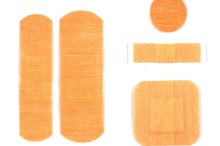Antibiotics for a Puncture Wound
A puncture wound occurs when a sharp object penetrates the skin barrier. Nails are the culprit in 90 percent of puncture wounds, most often on the bottom of the foot, according to FamilyPracticeNotebook.com 2. Although deeper structures such as tendons, blood vessels and nerves can be injured from a penetrating object, the most common complication is infection. MayoClinic.com lists several factors that increase the risk of infection including wound depth, the presence of a retained foreign object and seeking medical help more than 24 hours after the wound occurs 4.
If you are experiencing serious medical symptoms, seek emergency treatment immediately.
Antibiotic Therapy
Antibiotic therapy is indicated for a puncture wound when the wound is infected or if medical help is sought more than 24 hours after the injury. According to The Merck Manual Online Medical Library, antibiotics are chosen based on the type of infecting bacteria 3. Most puncture wound infections are caused by the bacteria staphylococcus and streptococcus, and antibiotics used for puncture wound infections are known to be effective against these kinds of bacteria.
Localized Infection
Antibiotics Recommended for Infected Wounds
Learn More
Localized, superficial infections are the most common type of puncture wound infectious complication. Oral antibiotics are effective in treating uncomplicated wound infections as well as preventing serious infectious outcomes. The most commonly used antibiotics include cephalosporins such as cephalexin, penicillin-type drugs including amoxicillin-clavulanic acid or dicloxacillin, and erythromycin, a macrolide antibiotic.
- Localized, superficial infections are the most common type of puncture wound infectious complication.
- Oral antibiotics are effective in treating uncomplicated wound infections as well as preventing serious infectious outcomes.
Severe Infection
Hospitalization and intravenous antibiotics are required for extensive soft tissue infections from a puncture wound. Cellulitis, according to MayoClinic.com, is a deep tissue infectious complication of puncture wounds and is the most common serious infectious complication from a penetrating injury 124. Intravenous antibiotics used for cellulitis include pencillins such as piperacillin, ampicillin-sulbactam or ticarcillin-clavulanate as well as cephalasporins such as cefazolin.
Osteomyelitis
What Is the Difference Between Cellulitis & Mrsa?
Learn More
Osteomyelitis, the most dreaded complication of puncture wounds, is an infection of the bone and is very difficult to treat 1. Pseudomonas, a type of bacteria, is often the cause:
- of puncture wound osteomyelitis
- requires potent
- pseudomonas-specific antibiotics including the newer cephalosporins ceftazidime or cefepime
- or the quinolone antibiotic ciprofloxacin
Surgery may be required to debride the infected bone.
Related Articles
References
- MedlinePlus: Cuts and Puncture Wounds
- MayoClinic.com: Puncture Wounds--First Aid
- The Merck Manuals Online Medical Library: Antibiotics
- MayoClinic.com: Cellulitis
- U.S. National Library of Medicine. MedlinePlus. Cuts and Puncture Wounds. Updated 01/12/15. https://medlineplus.gov/ency/article/000043.htm
- Kasper, Dennis L.., Anthony S. Fauci, and Stephen L.. Hauser. Harrison's Principles of Internal Medicine. New York: Mc Graw Hill education, 2015. Print.
- U.S. National Library of Medicine. MedlinePlus. Cuts and Puncture Wounds. Updated 01/12/15.
Writer Bio
Kathy Jutila has been writing health-related articles since 1979. Her work has appeared in "Infection and Immunity," "American Review of Respiratory Diseases," "Inflammation" and "Circulation." Jutila received a Bachelor of Science in biology, and a Master of Science in microbiology from Montana State University. She also holds a Doctorate of Medicine from the University of New Mexico.








